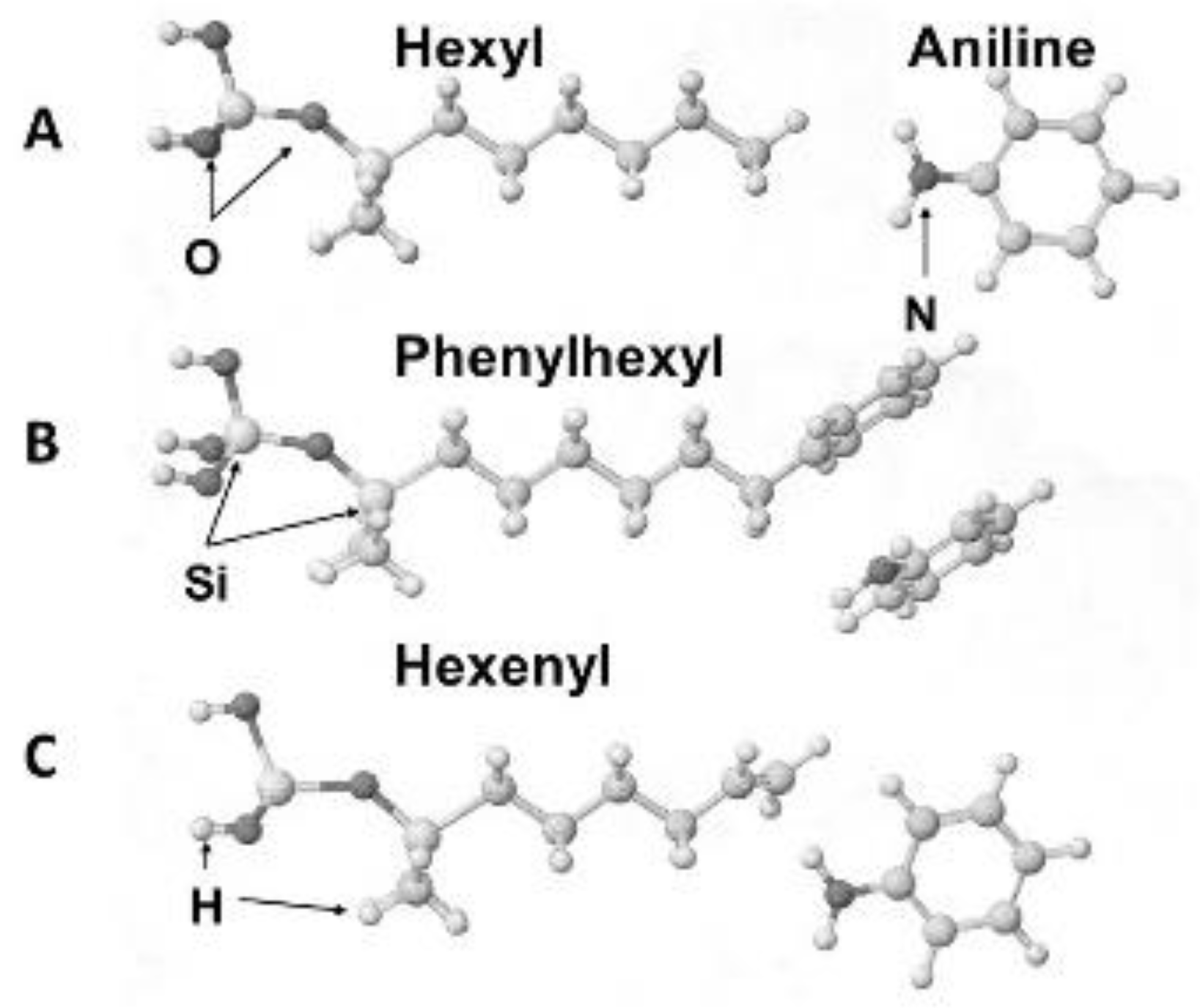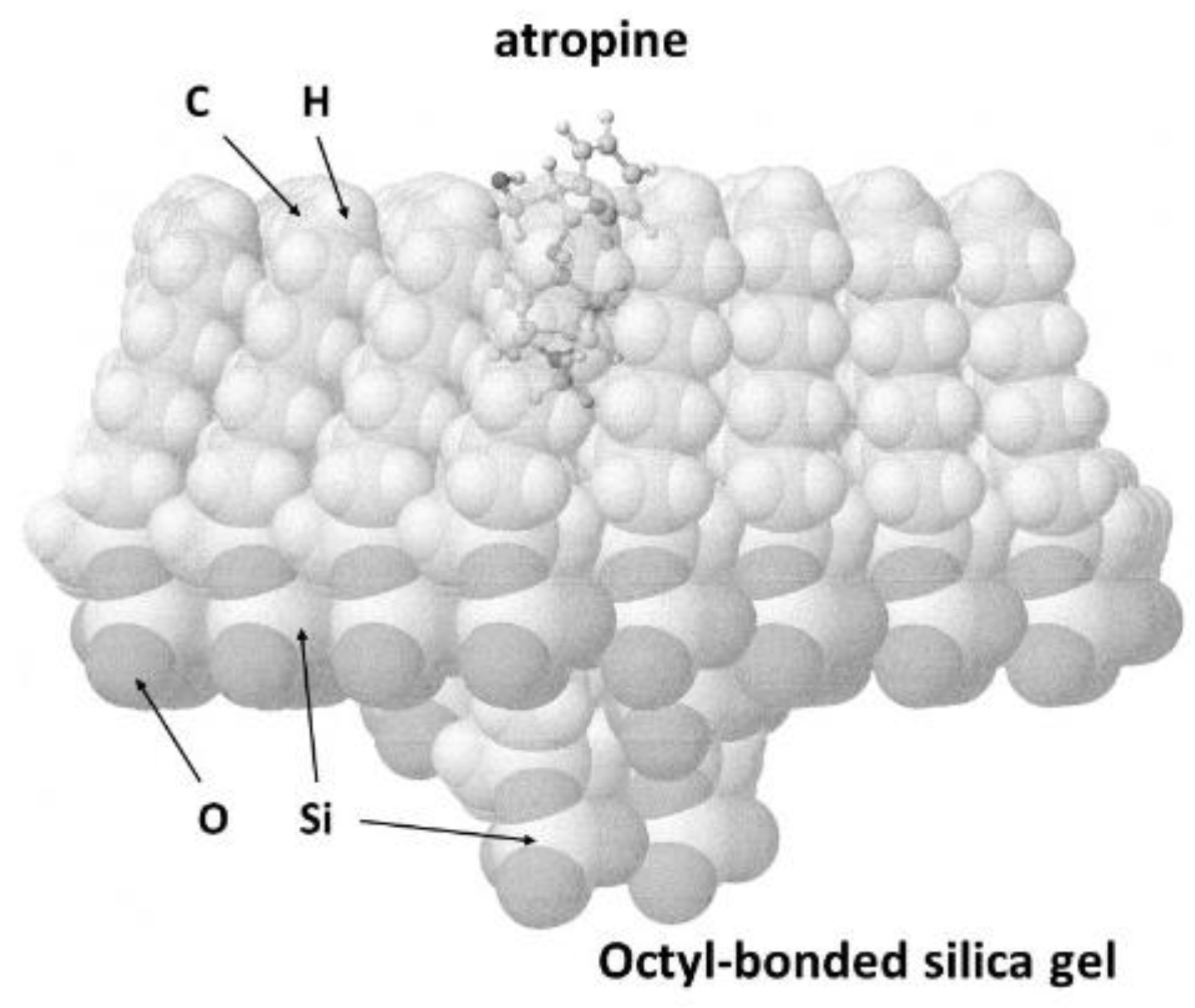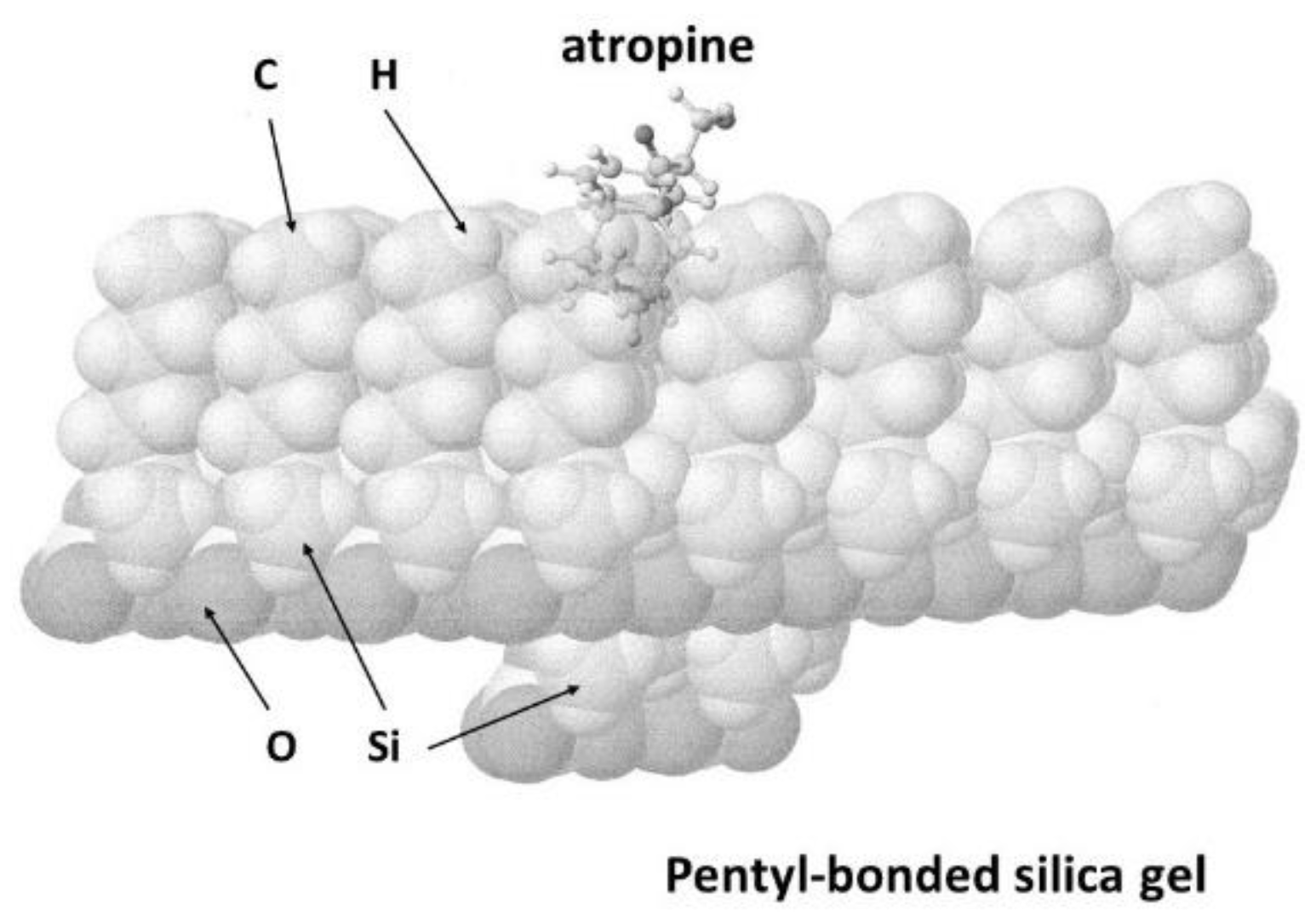Quantitative Explanation of Basic Compound Retention Mechanisms in Reversed-Phase Mode Liquid Chromatography
Abstract
1. Introduction
2. Experimental
3. Results and Discussion
4. Conclusion
Funding
Conflicts of Interest
References
- Kurganov, A.; Trudinger, U.; Isaeva, T.; Unger, K. Native and modified alumina, titania and zirconia in normal and reversed-phase high-performance liquid chromatography. Chromatographia 1996, 42, 217–222. [Google Scholar] [CrossRef]
- McCalley, D.V. Effect of organic solvent modifier and nature of solute on the performance of bonded silica reversed-phase columns for the analysis of strongly basic compounds by high-performance liquid chromatography. J. Chromatogr. A 1996, 738, 169–179. [Google Scholar] [CrossRef]
- Andrisano, V.; Makamba, H.; Bovini, E.; Cavrini, V.; Zappoli, S. HPLC analysis of basic organic compounds in a multicomponent ion-interaction system: A mechanistic study. Chromatographia 1998, 47, 493–500. [Google Scholar] [CrossRef]
- Andersson, M.; Hultin, U.-K.; Sokolowski, A. Effects of amine additives on the resolution of antipsychotic and antidepressant drugs on a cyanoalkyl HPLC column. Chromatographia 1998, 48, 770–776. [Google Scholar] [CrossRef]
- Vervoort, R.J.M.; Ruyter, E.; Debets, A.J.J.; Claessens, H.A.; Cramers, C.A.; De Jong, G. Characterization of reversed-phase stationary phases for the liquid chromatographic analysis of basic pharmaceuticals by thermodynamic data. J. Chromatogr. A 2002, 964, 67–76. [Google Scholar] [CrossRef]
- Wu, A.-B.; Huang, M.-C.; Ho, H.-L.; Yeh, G.-C.; Sheu, M.-T. Investigation on liquid chromatographic separation of basic compounds using silica column with aqueous/organic mobile phase containing triethylamine and acetic acid. Biomed. Chromatogr. 2004, 18, 443–449. [Google Scholar] [CrossRef]
- Wang, X.; Carr, P.W. An unexpected observation concerning the effect of anionic additives on the retention behavior of basic drugs and peptides in reversed-phase liquid chromatography. J. Chromatogr. A 2007, 1154, 165–173. [Google Scholar] [CrossRef]
- Peng, L.; Farkas, T. Analysis of basic compounds by reversed-phase liquid chromatography-electrospray mass spectrometry in high-pH mobile phases. J. Chromatogr. A 2008, 1179, 131–144. [Google Scholar] [CrossRef]
- Calabuig-Hernandez, S.; Garcia-Alvarez-Coque, M.C.; Ruiz-Angel, M.J. Performance of amines as silanol suppressors in reversed-phase liquid chromatography. J. Chromatogr. A 2016, 1465, 98–106. [Google Scholar] [CrossRef]
- Manetto, S.; Mazzoccanti, G.; Ciogli, A.; Villani, C.; Gasparrini, F. Ultra-high performance separation of basic compounds on reversed-phase columns packed with fully/superficially porous silica and hybrid particles by using ultraviolet transparent hydrophobic cationic additives. J. Sep. Sci. 2020, 43, 1653–1662. [Google Scholar] [CrossRef]
- Hanai, T. Chromatography in silico for basic drugs. J. Chromatogr. Rel. Technol. 2005, 28, 2163–2177. [Google Scholar] [CrossRef]
- Stella, C.; Rudaz, S.; Mottaz, M.; Carrupt, P.-A.; Veuthey, J.-L. Analysis of basic compounds at high pH values by reversed-phase liquid chromatography. J. Sep. Sci. 2004, 27, 284–292. [Google Scholar] [CrossRef] [PubMed]
- Hanai, T.; Masuda, Y.; Homma, H. Chromatography in silico; retention of basic compounds on a carboxyl ion exchanger. J. Liq. Chromatogr. Rel. Technol. 2005, 28, 3087–3097. [Google Scholar] [CrossRef]
- Luo, H.; Ma, L.; Zhang, Y.; Carr, P.W. Synthesis and characterization of silica-based hyper-crosslinked sulfonate-modified reversed stationary phases. J. Chromatogr. A 2008, 1182, 41–55. [Google Scholar] [CrossRef] [PubMed]
- Luo, H.; Ma, L.; Paek, C.; Carr, P.W. Application of silica-based hyper-crosslinked sulfonate-modified reversed stationary phases for separating highly hydrophilic basic compounds. J. Chromatogr. A 2008, 1202, 8–18. [Google Scholar] [CrossRef]
- Morgan, P.E.; Manwaring, V.; Flanagan, R.J. HPLC of basic drugs using non-aqueous ionic eluents: Evaluation of a 3 μm strong cation-exchange material. Biomed. Chromatogr. 2010, 24, 318–323. [Google Scholar] [CrossRef]
- Zhang, Y.; Carr, P.W. Novel ultra-stable silica-based stationary phases for reversed phase liquid chromatography-Study of a hydrophobically assisted weak acid cation exchange phase. J. Chromatogr. A 2011, 1218, 763–777. [Google Scholar] [CrossRef][Green Version]
- Mosiashvili, L.; Chankvetadze, L.; Farkas, T.; Chankvetadze, B. On the effect of basic and acidic additives on the separation of the enantiomers of some basic drugs with polysaccharide-based chiral selectors and polar organic mobile phases. J. Chromatogr. A 2013, 1317, 167–174. [Google Scholar] [CrossRef]
- Huo, Z.; Wan, Q.; Chen, L. Synthesis and evaluation of porous polymethylsilsesquioxane microspheres as low silanol activity chromatographic stationary phase for basic compound separation. J. Chromatogr. A 2018, 1553, 90–100. [Google Scholar] [CrossRef]
- Hanai, T.; Homma, H. Computational chemical prediction of the retention factor of aromatic acids. J. Liq. Chromatogr. Rel. Technol. 2002, 25, 1661–1676. [Google Scholar] [CrossRef]
- Hanai, T.; Mizutani, C.; Homma, H. Computational chemical simulation of chromatographic retention of phenolic compounds. J. Liq. Chromatogr. Rel. Technol. 2003, 26, 2031–2039. [Google Scholar] [CrossRef]
- Hanai, T. Simulation of chromatography of phenolic compounds with a computational chemical method. J. Chromatogr. A 2004, 1027, 279–287. [Google Scholar] [CrossRef]
- Hanai, T. Chromatography in silico, basic concept in reversed-phase liquid chromatography. Anal. Bioanal. Chem. 2005, 382, 708–717. [Google Scholar] [CrossRef] [PubMed]
- Hanai, T. Chromatography in silico, quantitative analysis of retention mechanisms of benzoic acid derivatives. J. Chromatog. A 2005, 1087, 45–51. [Google Scholar] [CrossRef] [PubMed]
- Hanai, T. Quantitative explanation of retention mechanisms in reversed-phase mode liquid chromatography, and utilization of typical reversed-phase liquid chromatography for drug discovery. Cur. Chromatogr. 2019, 6, 52–64. [Google Scholar] [CrossRef]
- Hanai, T. Quantitative in Silico Chromatography: Computational Modeling of Molecular Interactions; Royal Society of Chemistry: Cambridge, UK, 2014; pp. 1–338. ISBN 978-1-84973-991-7. [Google Scholar]
- Hanai, T.; Hatano, N.; Nimura, T.; Kinoshita, T. Molecular recognition in chromatography aided by computational chemistry. Supramol. Chem. 1994, 3, 243–247. [Google Scholar] [CrossRef]
- Hanai, T. HPLC, A Practical Guide; Royal Society of Chemistry: Cambridge, UK, 1999; pp. 1–134. ISBN 0-85404-515-5. [Google Scholar]
- Craig, P.N. Drug compedium, in Comprehensive Medicinal Chemistry: The Rational Design, Mechanic study and therapeutic. In Application of Chemical Compounds; Hansch, C., Sammes, P.G., Taylor, J.B., Eds.; Pergamon Press: Oxford, UK, 1990; Volume 6, pp. 237–965. [Google Scholar]
- Hanai, T. Evaluation of measuring methods of human serum albumin-drug binding affinity. Hanai, Toshihiko. Curr. Pharm. Anal. 2007, 3, 205–212. [Google Scholar] [CrossRef]




| Benzene Substitutes | Hammett’s σ Constant | apc of Group Unit: au | apc of Head Atom | apc of Balance | apc of p-Hydrogen | log P | pKa |
|---|---|---|---|---|---|---|---|
| p-Amino | −0.57 | 0.118 | H 0.255 | 0.041 | 0.159 | 1.03 | 4.69 |
| p-Amino (I) | - | 0.809 | H 0.229 | 0.893 | 0.207 | - | - |
| p-Hydroxy | −0.38 | −0.081 | H 0.305 | 0.245 | 0.164 | 1.54 | 10.02 |
| p-Methyl | −0.14 | 0.066 | H 0.107 | 0.092 | 0.158 | 2.59 | - |
| Hydrogen | 0.00 | 0.156 | H 0.156 | 0.000 | 0.156 | 2.06 | - |
| p-Fluoro | 0.06 | −0.198 | F −0.198 | 0.365 | 0.167 | 2.28 | - |
| p-Chloro | 0.24 | −0.051 | Cl −0.051 | 0.214 | 0.163 | 2.81 | - |
| p-Carboxy | 0.44 | −0.105 | H 0.324 | 0.269 | 0.164 | 1.79 | 4.20 |
| p-Carboxy(I) | - | −0.808 | H −0.647 | 0.931 | 0.123 | - | - |
| Substitute | apc | Substitute | apc | Substitute | apc |
|---|---|---|---|---|---|
| Ionized amino | 0.718 | Vinyl | −0.061 | Ionized carboxy | −0.888 |
| Methyl | −0.005 | Carboxy | −0.130 | ||
| Phenyl | −0.028 | Amino | −0.138 | apc unit: atomic unit (au) |
| Analytes | MIHB | MIES | MIVW | apc | apc | Atomic Distance |
|---|---|---|---|---|---|---|
| kcal mol−1 | au | Å | ||||
| Hexyl-phase | CH3 | atom or group | ||||
| Aniline | 0.000 | −0.011 | 0.766 | −0.037 | 0.208 H | 3.0 |
| Ionized aniline | 0.000 | 0.144 | 0.808 | −0.069 | 0.840 NH3 | 3.5 |
| Benzene | 0.000 | −0.026 | 0.985 | −0.007 | 0.158 H | 3.0 |
| Methylbenzene | 0.002 | 0.020 | −2.155 | −0.008 | 0.069 CH3 | 3.5 |
| Chlorobenzene | 0.001 | −0.006 | 2.399 | 0.000 | Contact face ClBz | 4.0 |
| Phenol | 0.000 | −0.031 | 0.988 | −0.009 | 0.166 H | 3.0 |
| Benzoic acid | 0.005 | −0.023 | 1.006 | −0.012 | 0.166 H | 3.0 |
| Ionized benzoic acid | 0.000 | −0.189 | 0.675 | 0.059 | −0.860 COO- | 3.5 |
| Phenylhexyl-phase | Phenyl | |||||
| Aniline | 0.292 | −0.027 | 5.367 | −0.060 | 0.844 Total | 3.5 |
| Ionized aniline | 0.000 | 0.189 | 1.044 | −0.108 | 0.844 NH3 | 3.5 |
| Benzene | 0.000 | 0.009 | 0.783 | −0.076 | 0.156 H | 3.5 |
| Methylbenzene | 0.000 | 0.014 | 1.116 | −0.076 | 0.068 CH3 | 3.5 |
| Chlorobenzene | 0.000 | −0.022 | 0.751 | −0.074 | −0.053 Cl | 4.0 |
| Phenol | 6.922 | 0.085 | 2.723 | −0.067 | −0.084 OH | 3.5 |
| Benzoic acid | 6.914 | 0.030 | 2.313 | −0.062 | −0.108 COOH | 3.0 |
| Ionized benzoic acid | 0.000 | −0.193 | 0.745 | −0.040 | −0.864 COO- | 3.5 |
| Hexenyl-phase | Vinyl | |||||
| Aniline | −0.056 | −0.031 | 1.732 | −0.051 | 0.267 H/NH2 | 3.5 |
| Ionized aniline | 0.001 | 0.169 | 3.319 | −0.060 | 0.159 Ph | 3.5 |
| Benzene | 0.002 | −0.026 | 2.881 | −0.051 | 0.000 Bz | 3.0 |
| Methylbenzene | 0.001 | −0.019 | 0.908 | −0.058 | 0.071 CH3 | 4.0 |
| Chlorobenzene | 0.003 | 0.005 | 3.565 | −0.058 | 0.056 Ph | 4.0 |
| Phenol | 2.305 | 0.071 | 2.187 | −0.055 | −0.084 OH | 3.5 |
| Benzoic acid | 2.324 | −0.008 | 1.222 | −0.055 | −0.110 COOH | 3.5 |
| Ionized benzoic acid | 0.001 | −0.195 | 3.328 | −0.061 | −0.136 Ph | 3.5 |
| Chemicals | log P | pKa | log k | |||||
|---|---|---|---|---|---|---|---|---|
| Phase | Hexenyl | Pentyl | Octyl | |||||
| pH | 3.0 | 10.0 | 3.0 | 10.0 | 3.0 | 10.0 | ||
| Aniline | 4.63 | −0.866 | −0.265 | −1.143 | −0.515 | −0.995 | −0.395 | |
| Atropine | 0.16 | 9.6 | −1.033 | 0.742 | 0.901 | 0.449 | −0.731 | 0.611 |
| Caffeine | 0.07 | 0.6 | −0.271 | −0.471 | −0.714 | −0.763 | −0.668 | −0.660 |
| Carbamazepine | 1.98 | 13.9 | 0.465 | 0.461 | 0.207 | 0.233 | 0.318 | 0.407 |
| Dextromethorphan | 3.99 | 8.3 | −0.207 | 1.599 | −0.079 | 1.292 | 0.077 | 1.625 |
| Diazepam | 3.18 | 3.3 | - | 1.001 | 0.701 | 0.753 | 0.873 | 0.994 |
| Isoproterenol | 0.08 | 8.6 | - | −0.599 | - | −0.767 | - | −0.716 |
| Lidocaine | 1.98 | 7.9 | −0.919 | 1.011 | −0.635 | 0.878 | −0.519 | 1.094 |
| Prazosin | 2.16 | 6.5 | −0.815 | 0.433 | −0.852 | −0.048 | −0.692 | 0.120 |
| Procaine | 2.24 | 8.11 | - | 0.513 | −1.647 | 0.239 | −1.512 | 0.410 |
| Pyridine | - | 5.19 | −0.555 | −0.212 | −1.206 | −0.361 | −0.734 | −0.370 |
| Quinine | 3.20 | 4.1 | −0.347 | 1.116 | −0.523 | 0.858 | −0.294 | 1.134 |
| Scopolamine | −0.20 | 7.75 | −1.385 | 0.169 | −1.149 | −0.046 | −0.965 | 0.097 |
| Terbutaline | 0.48 | 8.8 | - | - | −2.290 | −0.589 | −2.242 | −0.546 |
| Theophylline | −0.02 | 3.5/8.81 | −0.337 | - | −0.797 | −1.725 | −0.766 | −1.644 |
| Octyl Phase | Methanol Phase | Pentyl Phase | Hexenyl Phase | |||||||||||
|---|---|---|---|---|---|---|---|---|---|---|---|---|---|---|
| Chemicals | hb | es | vw | MIHB | MIES | MIVW | mMIHB | mMIES | MIHB | MIES | MIVW | MIHB | MIES | MIVW |
| Aniline (I) | 0.000 | 0.000 | 3.497 | 0.000 | 0.275 | 14.397 | 15.458 | 1.443 | ||||||
| Aniline (M) | −1.334 | 0.000 | 3.416 | 0.003 | 0.000 | 14.440 | 17.017 | 0.618 | 0.008 | 0.008 | 12.655 | 0.902 | 0.020 | 11.457 |
| Atropine (I) | −3.435 | −0.716 | 13.689 | −0.513 | −0.102 | 39.183 | 23.344 | 4.418 | ||||||
| Atropine (M) | −3.451 | −1.041 | 11.237 | −0.143 | −0.066 | 30.557 | 21.767 | 3.511 | −0.016 | 0.243 | 24.199 | 0.267 | 0.082 | 25.724 |
| Caffeine (M) | 0.000 | −47.421 | 4.888 | 0.000 | 0.064 | 22.006 | 19.422 | 3.822 | 0.000 | −0.073 | 15.237 | 0.000 | −0.290 | 16.519 |
| Carbamazepine (I) | −10.401 | −7.183 | 19.781 | −0.059 | 0.290 | 26.667 | 37.251 | 1.371 | 0.471 | 0.206 | 23.292 | 4.820 | 0.553 | 18.935 |
| Dextromethorphan (I) | 0.000 | 0.120 | 14.724 | 0.000 | 0.284 | 37.330 | 14.153 | 1.683 | 0.000 | 0.235 | 30.468 | 0.000 | 0.540 | 29.188 |
| Diazepam (I) | −4.187 | 7.476 | 13.611 | 0.000 | 0.278 | 29.927 | 28.146 | 3.325 | ||||||
| Diazepam (M) | 0.000 | 0.675 | 15.243 | 0.000 | −0.135 | 29.811 | 28.572 | 3.561 | 0.000 | 0.079 | 27.351 | 0.000 | −0.034 | 25.505 |
| Isoproterenol (I) | −3.015 | −0.041 | 6.071 | −0.109 | 0.148 | 24.456 | 18.451 | 8.710 | −0.067 | −0.036 | 22.832 | 2.171 | −1.152 | 19.705 |
| Lidocaine (I) | −2.146 | −19.762 | 12.606 | −0.007 | 1.377 | 27.698 | 22.064 | 3.183 | ||||||
| Lidocaine (M) | −2.157 | 5.744 | 11.009 | 0.001 | 1.411 | 33.526 | 18.134 | 2.940 | −0.010 | 1.613 | 25.320 | 0.238 | 1.098 | 25.184 |
| Prazosin (I) | 0.000 | 4.104 | 13.136 | 0.000 | 0.225 | 30.800 | 24.863 | 3.961 | ||||||
| Prazosin (M) | −1.257 | 0.633 | 13.800 | 0.008 | 0.003 | 26.098 | 27.836 | 3.303 | 0.003 | 0.109 | 26.141 | 0.192 | 0.862 | 27.029 |
| Procaine (I) | 0.000 | −1.333 | 12.553 | 0.000 | 0.493 | 27.787 | 19.899 | 3.697 | ||||||
| Procaine (M) | −1.334 | −0.233 | 7.796 | 0.000 | −0.031 | 28.800 | 19.392 | 2.614 | 0.000 | −0.036 | 19.938 | 0.226 | −0.002 | 22.059 |
| Pyridine (I) | 0.000 | 0.000 | 3.206 | 0.000 | 0.322 | 12.146 | 12.948 | −1.064 | ||||||
| Pyridine (M) | 0.000 | 0.000 | 2.858 | 0.000 | 0.009 | 12.738 | 12.368 | −0.691 | 0.000 | 0.009 | 10.893 | 0.000 | 0.015 | 9.983 |
| Quinine (I) | −4.484 | −1.001 | 12.917 | −0.078 | 0.555 | 30.833 | 23.907 | −0.127 | ||||||
| Quinine (M) | −4.606 | 0.015 | 14.782 | 0.039 | 0.005 | 35.958 | 24.296 | 0.524 | −0.086 | −0.008 | 26.651 | 0.541 | −0.061 | 29.134 |
| Scopolamine (I) | −3.624 | −2.327 | 10.343 | 0.019 | 0.187 | 27.943 | 24.840 | 6.267 | ||||||
| Scopolamine (M) | −0.436 | −1.763 | 8.506 | −0.034 | −0.082 | 26.804 | 19.936 | 4.169 | 0.025 | −0.127 | 28.631 | 2.625 | 0.473 | 24.690 |
| Terbutaline (I) | −3.028 | −1.823 | 6.308 | −0.054 | −0.307 | 23.181 | 16.154 | 9.079 | −0.045 | −0.406 | 24.288 | 2.851 | −0.908 | 19.991 |
| Theophylline (M) | −0.485 | −47.408 | 6.300 | 0.011 | −0.123 | 20.769 | 16.663 | 3.280 | ||||||
| Theophylline (I) | 0.000 | −46.133 | 5.657 | 0.000 | −0.294 | 22.086 | 15.781 | 5.488 | 0.000 | −0.167 | 15.232 | 0.000 | −0.810 | 15.606 |
Publisher’s Note: MDPI stays neutral with regard to jurisdictional claims in published maps and institutional affiliations. |
© 2020 by the author. Licensee MDPI, Basel, Switzerland. This article is an open access article distributed under the terms and conditions of the Creative Commons Attribution (CC BY) license (http://creativecommons.org/licenses/by/4.0/).
Share and Cite
Hanai, T. Quantitative Explanation of Basic Compound Retention Mechanisms in Reversed-Phase Mode Liquid Chromatography. Separations 2020, 7, 61. https://doi.org/10.3390/separations7040061
Hanai T. Quantitative Explanation of Basic Compound Retention Mechanisms in Reversed-Phase Mode Liquid Chromatography. Separations. 2020; 7(4):61. https://doi.org/10.3390/separations7040061
Chicago/Turabian StyleHanai, Toshihiko. 2020. "Quantitative Explanation of Basic Compound Retention Mechanisms in Reversed-Phase Mode Liquid Chromatography" Separations 7, no. 4: 61. https://doi.org/10.3390/separations7040061
APA StyleHanai, T. (2020). Quantitative Explanation of Basic Compound Retention Mechanisms in Reversed-Phase Mode Liquid Chromatography. Separations, 7(4), 61. https://doi.org/10.3390/separations7040061




